2 MODEL TYPOLOGY
In models, simply put, masses, surfaces, and linear elements are employed as basic elements and arranged in relation to one another. These basic components do not only represent such architectural elements as walls and columns; through their interaction they also reveal architectural space in terms of a spatial composition. This relation emerges distinctly In models of buildings, and structural models in particular. It should be noted that membranes, films, wire mesh, and textiles comprise the planar elements, while wires and strings are considered linear elements.
Accordingly, there are three basic types of models, depending on the way such elements are employed: articulated solids, surfaces, and linear elements. Various hybrid categories are located between these types.

From this line of thinking, it follows that the primary function of model-making is to assemble solids, planes, and linear elements; transform them; connect them; arrange them; and in some cases apply color to their surfaces. Added to this is the possibility of using “found objects,” also called “ready-mades,” reinterpreting and inserting them into the model, or using them to construct the model as a collage.
In light of the various contexts in which models are implemented for study and analysis, as well as for developing forms and formal relationships, architectural models may be organized into three groups: topographic models, volumetric models, and specialty models. Included among topographic models are site models, landscape models, and models of gardens. Volumetric models subdivide into urban design models, architectural models, structural models, interior design models, and detail models. Specialty models would include object design and furniture models, as well as models used in acoustic analysis, lighting design, special structural solutions, or instruction. All models can be differentiated from one another in terms of how they are constructed, as compositions of massing, planes, or lines, or combinations thereof. In addition, there are three levels of refinement for models, each having distinct requirements and dialogical contexts, respectively. For example, a model may serve as a learning aid for an architecture student; a tool for discussion in a design committee; part of a competition entry; an exhibition piece; as a presentation for a client; a scale reproduction of a building that was demolished, still exists, or was never built; or a classroom display (such as a geometric model).
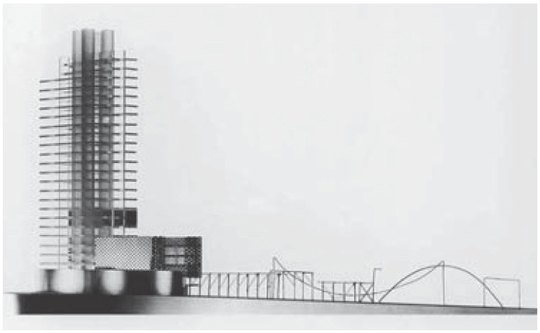
2-1 Building model, scale 1:500, Level of finishing: presentation model. Floors made of clear acrylic sheeting. Circulation core of solid acrylic sanded for a matte finish. Sides of base clad with perforated aluminum sheeting, spray-painted white, with a soldered wire frame. The interaction of the solid, plane, and linear element is easily discerned.
Below, models are discussed in terms of the following groupings:
TOPOGRAPHIC MODELS
 Site models
Site models
 Landscape models
Landscape models
 Models of gardens
Models of gardens
VOLUMETRIC MODELS
 Urban design models
Urban design models
 Models of buildings
Models of buildings
 Structural models
Structural models
 Interior design models
Interior design models
 Detail models
Detail models
SPECIALTY MODELS
 Furniture design
Furniture design
 Design of objects
Design of objects
Models are part of our design process, which means that they represent an always changeable and changed state of a design project. Most of the time, even the most accurately made presentation model can only depict an interim stage in the process, while serving as a basis for decision-ma king in order to move the design process along. It is unusual for a model to be employed for producing working drawings, or during the construction phase, with the exception of detail models (which are used to study such things as exterior wall sections or stair details), structural models (used to develop alternatives and joints), and interior design models (for showing color palettes and the effects of material choices).
Finally, there are presentation models that depict historic buildings or a historic setting, and there are models made for use in displays and exhibitions.
There are three levels of refinement for making models, approximating the three main stages of the design process:
| Level 1: Preliminary design | Concept sketches Conceptual model |
| Level 2: Design development | Design drawings Working model |
| Level 3: Final project | Contract documents Final presentation model |
Each phase of the design process entails different requirements for models, the materials, and the tools to be used, as well as the work space. For instance, no special equipment or workshop is needed to make a conceptual model; however the material must be readily available and easily manipulated and crafted. The parameters for working models are already fixed, although the building volumes or groupings must be interchangeable, while their essential formal characteristics may already be worked out. In a presentation model, a design proposal is taken to a clear resolution. At this stage in the process, the model must also satisfy design requirements: the texture and color of materials used must be coordinated sensibly and purposefully. The spatial relations defined by the design are translated, clarified, and in some cases exaggerated, by the relationships and contrasts among materials. Finally, labels and scale and orientation (i.e., north arrow) symbols must also be incorporated in the presentation model. And at the very start of a presentation model one should be thinking about how it might be shipped, whether it might be disassembled and packed up, and how. Furthermore, consideration should be given to the task of photographing the model. How and where might openings be made in order to bring enough light into the model to illuminate it from inside? How may it be taken apart in order to properly position the camera?
Depending on design intention and material selection, building a presentation model requires more tools and power equipment, which in turn impose special demands on the workshop.
In summary, the levels of model finishing may be characterized as follows:
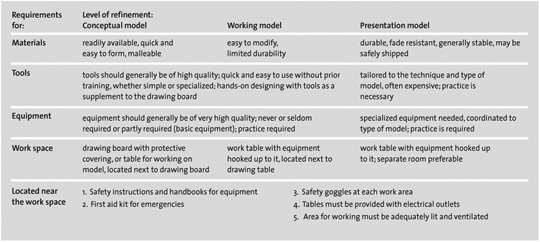
Combining model category and type with levels of finishing produces a typology of models, two types of which are described in greater depth in this book. Section 2.1 discusses topographic models, and section 2.2 describes building models. The following section reviews production techniques, materials, and tools, with reference to the three groups of models outlined.
2.1 TOPOGRAPHIC MODELS
The purpose of the topographic model is to represent an existing site: either a natural or a man-made landscape. The latter may be illustrated in a landscape model, while portions thereof can be shown in a garden model. There are also representations of urban spaces such as playgrounds, playing fields for sports, greenspaces, parks, and cemeteries. Squares and streetscapes belong both to this category of models and to models of buildings. In addition to showing the vegetation and contours of a landscape, topographic models show site circulation,
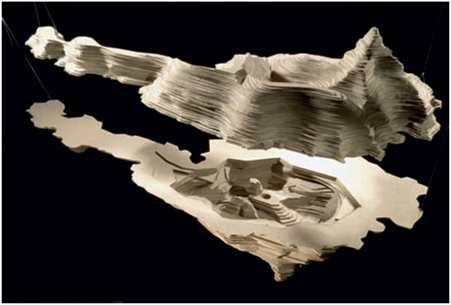
2-2 Site model, not to scale. An imaginary site made of gray cardboard, cut in section to show upper and lower realms.
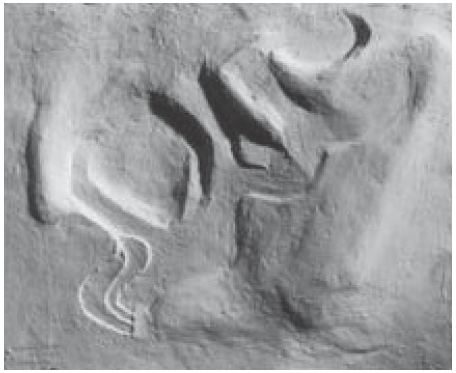
2-3 Site model made of plaster.
greenspaces, and water. They also include surface textures, such as paving and enclosures, as well as such scale-giving elements as street furniture, cars, and people. These models are built at many different scales, from general overviews to small detail, ranging anywhere from 1:2500 up to 1:50.
While site models commonly serve as the basis for designing a building, and are essentially accurately scaled representations of the surrounding context and its elements, landscape and garden models are able to show the spatial qualities of the site context. Landscape and garden models are typically built at larger scales in order to render materials such as surface coverings or paving, as well as special features of vegetation and site contours. It should be noted that the level of finishing among topographic models rarely includes “conceptual models.” Site models are always initially used as working models that can be altered later on, becoming in turn the basis for developing design ideas.
2.1.1 SITE MODELS
Site models mainly show the elevation of the topography (contours) and how the design affects it. Circulation, greenery, and water are also included. The line between a site model and a landscape model is blurred; site models are built at all scales.
CONCEPTUAL MODELS
It is unusual to construct a site model on a base and use it as a conceptual model. When a site model is produced at this stage in the design process, it should suffice to treat it as a working model. The most important requirement is that the form of the site still be easily modified without difficulty. It must be possible to make significant changes to the site topography. The ground plane of a conceptual site model may be represented simply, as a level or a sloping surface.
WORKING MODELS
These provide a scale reproduction of a site with information about existing circulation, structures, streets, greenery, and water areas. With further elaboration they may be made into presentation models, although they must nevertheless function like a working model in order to design the site.
PRESENTATION MODELS
Presentation models make a final proposal in terms of topography, circulation routes, streets, greenspaces, and water areas. They also present trees and tree groupings, both existing and planned. The quality of finish work on a presentation model depends on the intended purpose, expression, and effect.
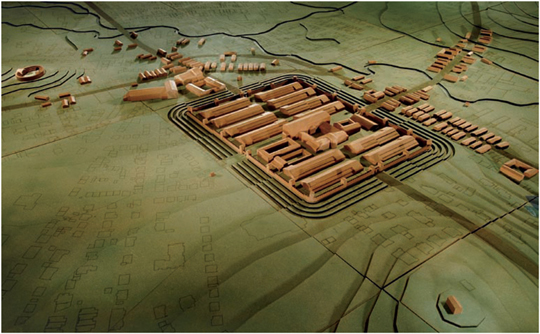
2-4 Site model, scale 1:1000. Base made of MDF board, 13 mm thick. Elevation contours on the site are made of 3 mm thick layers of MDF board, laser-cut and stacked. The layout of existing buildings was inscribed using a laser cutter. The historic building fabric was made of pear wood, shaped into simple massing volumes.
2.1.2 LANDSCAPE MODELS
The term landscape model indicates a three-dimensional representation of a landscape design that goes beyond what is typically shown in a site model, built at larger scales, from 1:500 and 1:1000 up to 1:2500, and in some cases, 1:5000. Such models depict roads, greenspaces, water, trees, clusters of trees, wooded areas, linear planting (bushes), as well as simple massing representing buildings and building complexes. Landscape models place an emphasis on rendering spaces and contours being reshaped within a landscape, as well as the depiction of prominent structures such as lookout towers, retaining walls, high-tension masts, etc. Planning projects, shown as massing, may be integrated into landscape models. Landscape models are required for the design of landscaped gardens, expansive parks, garden shows, and recreational areas located near cities.
CONCEPTUAL MODELS
Simple technical methods are used to design spatial landscapes on the base of a site model (as a working model). It must be possible to change the site.
WORKING MODELS
These give precise information a bout the sequences, form, and size of spaces, along with accurate information about orientation and sight lines.
PRESENTATION (FINAL) MODELS
Presentation models are concrete, specific representations of spatial conditions, vegetation, and their relationship to existing and new construction.
2.1.3 GARDEN DESIGN MODELS
Models of garden designs are defined as larger scale detail portions of landscape models, at scales of 1:500, 1:200, 1:100 and occasionally 1:50. Such models focus on open spaces within smaller planning projects and around freestanding buildings, as well as urban spaces. They may include hiking trails, nature trails, exercise paths, playgrounds and playing fields; outdoor public pools, pools for aquatic sports, campgrounds, bathing areas, allotment gardens, cemeteries, memorials, and monuments; botanical gardens and zoos; various kinds of greenspaces, open-air theaters, public parks, historic gardens, terraces, and roof gardens; pedestrian spaces, courtyards, and squares. These models also show smaller buildings, fountains, monuments, lookout towers, sculptures, and the like.
The emphasis of this type of spatial rendering is on the modulation of the ground plane and site contours, vegetation, layout of circulation routes and built exterior spaces, as well as curbs, enclosures, and walls. In addition, objects that create a sense of scale, such as human figures, vehicles, lighting, and the like, are added. Sometimes a programmatic requirement calls for a connection between the model of a building and the model of a garden. In such cases, the two types of models must be coordinated so that they can be put together to form one model.
CONCEPTUAL MODELS
These models involve altering the topography of the site, its circulation systems, and spatial composition, which are represented using simple techniques and the background of an accurate, not yet finished model. Spatial relationships, lines of sight, and potential vantage points are explored, and such special features as monuments, fountains, towers, groves, individual trees, rock outcroppings, or boulders are arranged in a composition and rendered in pliable materials or represented by found objects (“ready-mades”; see section 3.1.8).
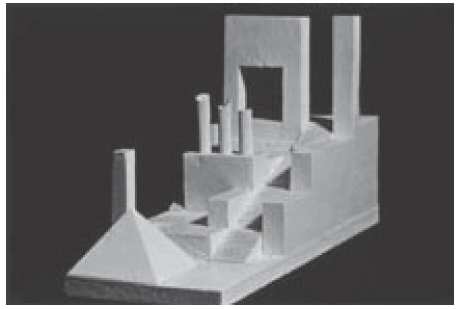
2-5 Model of an “art garden,” not built to scale. Base constructed of 8 mm particleboard. Building massing is of solid wood painted white. Columns are made of dowels.
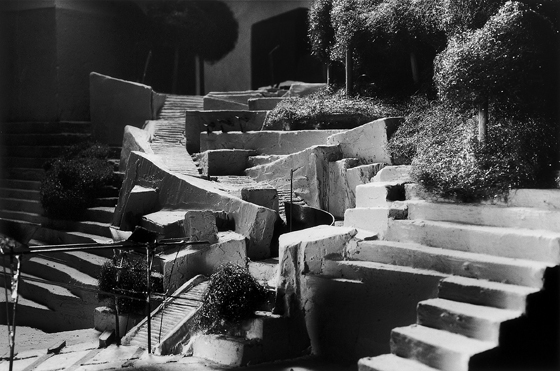
2-6 Formal design of paths and spaces in a public space, scale 1:50. Particleboard base, 12 mm thick. Topographic contours of spackled Styrofoam. Trees made of small branches and steel wool; soldered galvanized wire for trellises.
If they are part of the design, building massing is integrated into the site and alternative layouts are explored. In addition to sketches, topographic site plans and photographs of the existing site are required.
WORKING MODELS
These offer more exact information regarding the choice of vegetation and the surface treatment of circulation spaces, greenspaces, and water areas. Built volumes and the ways in which they are integrated into the spatial context are represented in greater detail. This type of model still permits design changes; built volumes and single objects like fountains, monuments, etc. are made as separate pieces that can be repositioned. The locations of new vegetation are left open. In the working model, materials are compiled for the final presentation model and for the project itself, and their textures and colors are discussed.
PRESENTATION MODELS
Using specially made materials, these models offer the most accurate rendering of vegetation, surface textures, and materials, to demonstrate their impact on the design of a garden space. Built volumes are shown in detail, along with the way they are sited and accessed within the site. A presentation model can no longer be altered and shows the final stage of a design project.
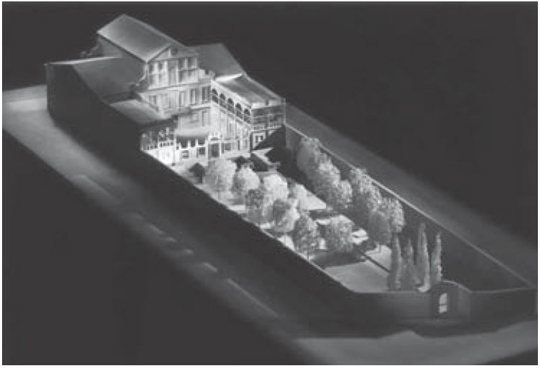
2-7 Garden theater, scale 1:100. Base of 15 mm plywood. Airplane plywood used for building; elevations are applied to massing to create relief. Loofah (massage sponge) was used for vegetation.
2.2 VOLUMETRIC MODELS
This category of models is subdivided into urban design models, models of buildings, structural models, interior design models, and detail models. Common to all of them is their ability to describe the spatial, formal, and structural characteristics of buildings. The following aspects should be considered:
 How a design project fits into the existing context, including how it integrates into the site model itself. In the latter, topographic features such as contour relief, surface texture, and existing vegetation are shown (see above).
How a design project fits into the existing context, including how it integrates into the site model itself. In the latter, topographic features such as contour relief, surface texture, and existing vegetation are shown (see above).
 The existing development within which a design project is to be inserted.
The existing development within which a design project is to be inserted.
 Existing building ensembles, streets, and circulation systems, which are important in terms of access to and from the new design project.
Existing building ensembles, streets, and circulation systems, which are important in terms of access to and from the new design project.
In the construction of a volumetric model, depending on the goal, emphasis can be placed on the visualization of three-dimensional, spatial form, on the allocation of program functions, or on the structural configuration. Below are aspects that may be of significance to the model:
FORM
 Formal design and building connections
Formal design and building connections
 Form, scale, and spatial sequence
Form, scale, and spatial sequence
 Light and the distribution of light
Light and the distribution of light
 Materials, textures, and colors
Materials, textures, and colors
 Views and lines of sight
Views and lines of sight
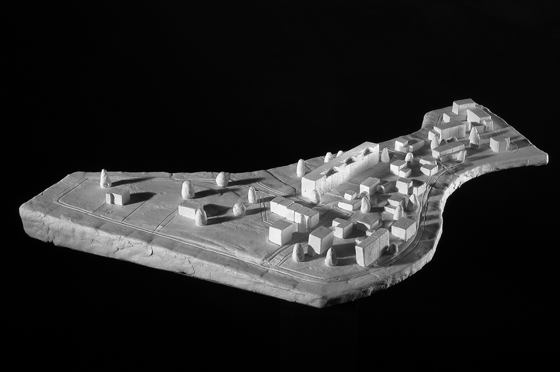
2-8 Conceptual model for an urban design project, scale 1:500. Base of 8 mm chipboard. Modeling clay (Plasticine) used to depict the site, buildings, and greenery in a single color. The routes of circulation systems are pressed into this material.
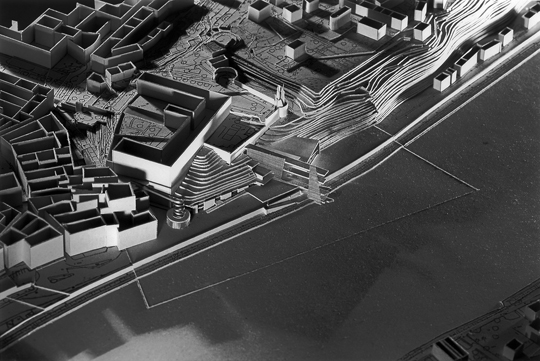
2-9 Working model for an urban design project, scale 1:500. Base of 10 mm chipboard. Topography and design information transferred onto gray cardboard. Buildings are expressed as simple massing or spatial envelopes, with the design project in acrylic strips for contrast. Water surface set off in dark colored paper.
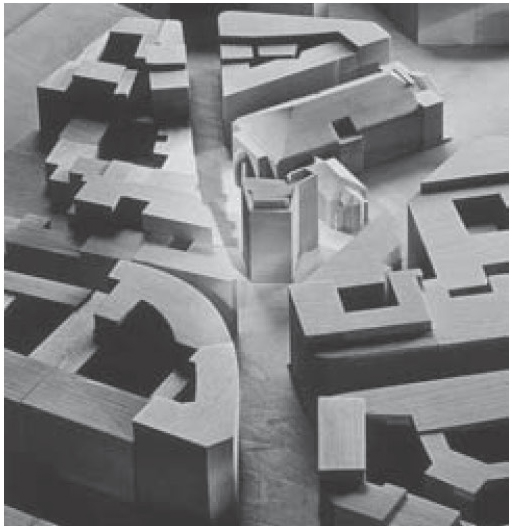
2-10 Urban design model, scale 1:500. Base of 13 mm plywood. Existing construction is shown as simple massing in solid alder wood. To ensure that it stands out, the new building project is made using slices of wood.
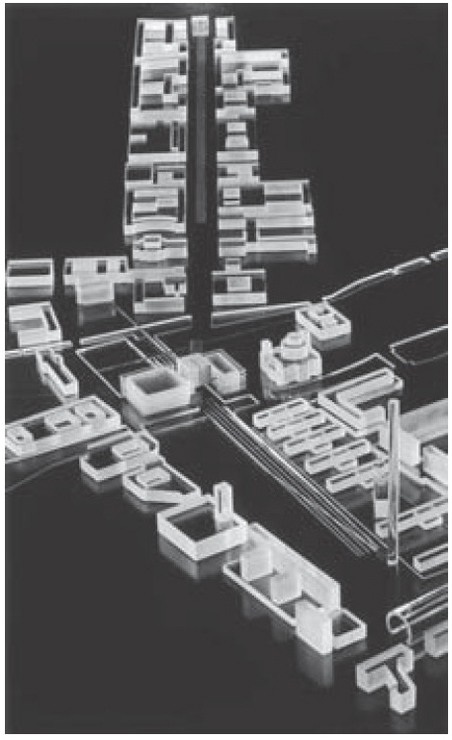
2-11 Urban planning model, scale 1:5000. Base of 13 mm MDF board. Site and water surfaces of black photographic mounting board, with the water set lower. Development is shown as massing using solid acrylic volumes. The designers aimed for a cool, technical aesthetic.
FUNCTIONS
 Allocation and distribution of volumes and spaces
Allocation and distribution of volumes and spaces
 Exterior and interior circulation
Exterior and interior circulation
 Uses
Uses
CONSTRUCTION
 Masonry
Masonry
 Wood
Wood
 Steel
Steel
 Bearing walls
Bearing walls
 Membrane and tensile structures
Membrane and tensile structures
In general, the divisions between urban planning, urban design, and architectural models have to do with scale. In urban planning and urban design models (at scales of 1:1000 and 1:500, up to 1:200), building ensembles and their various interrelationships are shown, as well as the resulting interstitial spaces and squares. By contrast, architectural models focus on the individual building and, depending on the design requirements, they are concerned with aspects of construction, function, and form. The scale determines whether the buildings are shown in their entirety or in sections and details.
2.2.1 PLANNING AND URBAN DESIGN MODELS
Planning and urban design models are typically made using topographic models. They are employed either as site models (scales ranging from 1:1000 to 1:500) or as detailed portions (scales of 1:500 up to 1:200). While models of urban design projects (for squares, streetscapes, arcades, etc.) may be larger scale (1:100 up to 1:50), planning and regional planning projects with diverse program requirements use scales smaller than 1:1000, such as 1:2500.
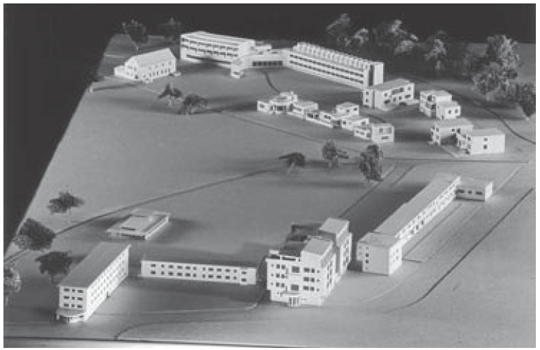
2-12 Urban design model, scale 1:200. Base of solid plywood, 21 mm thick, with structural reinforcement. Site made of gray cardboard; circulation and greenspaces built up in layers to create relief. Building massing of solid wood spray-painted gray, on which are attached elevations of punched windows made of polystyrene, 0.08 mm thick. Vegetation includes trees made with wire trunks and crowns of tinted foam padding. An example of an urban design model tending towards an architectural model, showing both the urban fabric and façades.
CONCEPTUAL MODELS
In an urban design project, the function of a conceptual model is to provide a rough idea of how urban spaces will be articulated in the massing, distribution, arrangement, and formation of built volumes and open spaces. Spatial and functional concepts can be tested out in the model using pliable materials, “ready-mades,” and other “game pieces” on a topographic (or contour) model.
WORKING MODELS
Working models of urban design projects show existing buildings, fixed and in presentation quality, while allowing for changes and playful experimentation with the portions being designed. New buildings show a tangible spatial form. Alternative schemes can be made as model inserts.
PRESENTATION MODELS
Presentation-quality urban design models depict the way in which the planned building or buildings will ultimately be integrated into existing built contexts and landscapes.
2.2.2 MODELS OF BUILDINGS
Volumetric models of architectural building design projects may be prepared at scales of 1:500 or 1:200 for inserting into urban design or topographic (planning) models, depending on the design scheme. More detailed information about the design of a building may of course be shown at 1:200 as well. At scales between 1:200 and 1:50, a model must often be limited to showing a building without any context. A building model shows the key compositional elements of facades and roof planes, the formal qualities of the building and its disposition, how it fits to the site, and the existing development. One option is to make parts of or full elevations transparent, allowing views of room layouts. Roofs and facades may also be detachable so that interior spaces can be shown. Lastly, the model may show individual floors, so that circulation and the arrangement and allocation of interior spaces can be made visible.
CONCEPTUAL MODELS
Using simple techniques and light, pliable materials, conceptual models show formal and spatial effects through contrasts in form, size, orientation, layout, tone (light to dark), color, and texture. The basic nature of conceptual models is their impromptu construction, as compositions that can be revised easily.
WORKING MODELS
Without yet committing to a final form of the project taking shape, a working model makes it possible to explore the formal and spatial qualities of a design in greater detail and distinction. The same is true of structural and organizational issues, which can be resolved with the help of the model. A working model is used to develop and examine relationships to potential development and the surrounding site. The form, composition, and sequence of spaces are more clearly defined, and the best solution is shown, and/or variations there of, for interior and exterior circulation spaces and their interaction. While a conceptual model focuses on the general shape of exterior massing, elevations and roof planes are more defined in the working model; openings, design elements, setbacks and projections, façade rhythms, and roofs are shown and their proportions are explored. If made with well-chosen materials and sufficiently precise workmanship, a working model can quite easily be used as a presentation model.
PRESENTATION MODELS
Presentation models show the final design of a building. They are typically made for presentation purposes only: for competitions, student design projects, or submissions to public and private selection committees. In addition to accurately showing topography and how the design project is sited within it, they also depict urban fabric and objects that enhance scale, such as cars, urban furniture, and people.
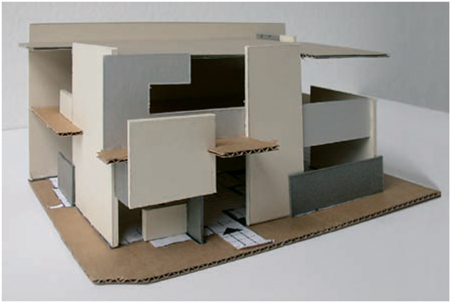
2-13 Conceptual model of a building, scale 1:100. Materials: various types of cardboard. Example of a successful preliminary model used to design a presentation model.
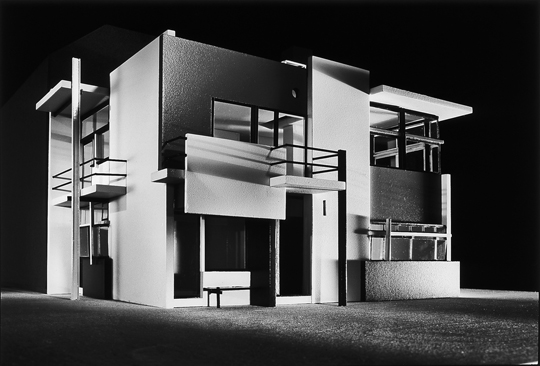
2-14 Architectural model, scale 1:100. Base of 16 mm MDF board. Using the conceptual model as a template, the floors and walls were cut from polystyrene and separately sprayed with color. Windows of acrylic sheeting with color-treated adhesive profiles. Railings and columns are brass profiles, with separate pieces soldered together after painting. The model allows views of the building’s interior.
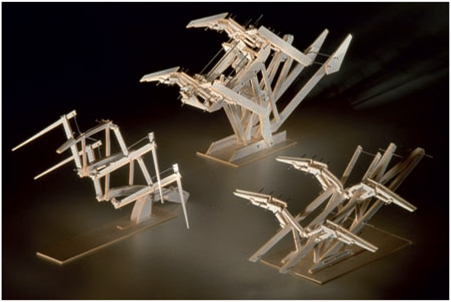
2-15 Detachable structural models. All parts made of decorative art board, accurately cut. Pins used for joints. Representation of a complex structure using basic techniques.
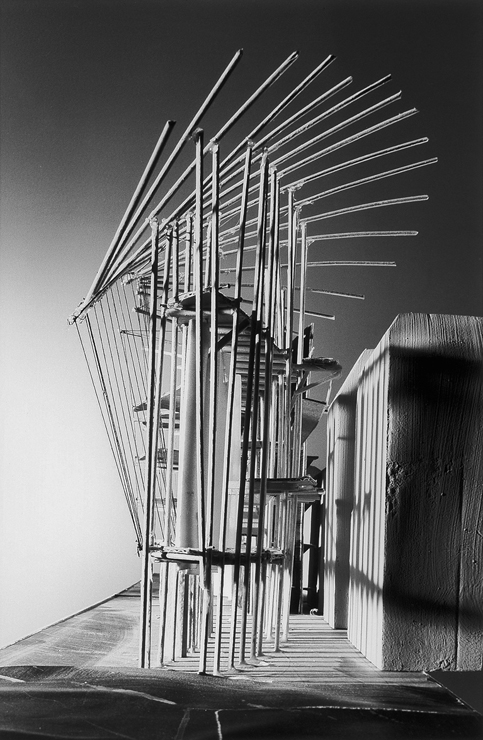
2-16 Conceptual model, scale 1:50. Inhabitable urban sculpture. Structure made of skewers. Existing buildings of painted foam.
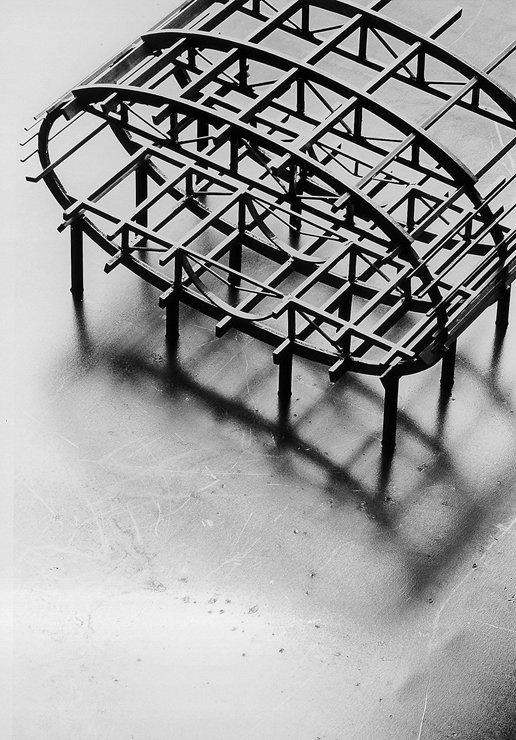
2-17 Structural section model, scale 1:50. Base of 4 mm sheet metal. Oval-shaped frame pieces of acrylic. Columns, beams, and stiffeners of soldered brass. Model spray-painted after completion.
2.2.3 STRUCTURAL MODELS
Structural models reveal the structural design of a building without reproducing its total form. Such structures may illustrate the function or circulation of a building, although the structural design is paramount. Using structural models, solutions to functional, technical, and structural problems in difficult spatial situations can often be found and presented to others, including engineers. Structural models are commonly derived from site models, since a particular topographical context often directly influences the design of a structure. They are executed at scales from 1:200 to 1:20.
CONCEPTUAL MODELS
Conceptual models are made with materials that are immediately available and easy to manipulate and fasten; often these are recycled or “ready-made” materials. They are intended first and foremost for preliminary studies of isolated questions and problems and initial ideas about structure, circulation, and the allocation of program functions. They often help designers visualize complicated spatial conditions in the early stages of a project for themselves and for potential partners. Generally speaking, they are built very quickly and are easily altered.
WORKING MODELS
Normally working models can be modified, but they often fix the final stage of a design. They are used to continue to develop details and address specific problems, in order to clarify them for others. After revising them a bit more accurately, they can normally be used as presentation models.
PRESENTATION MODELS
Precise structural models of finalized projects are built exclusively for presentations and informational purposes.
2.2.4 INTERIOR DESIGN MODELS
Usually these models show a single interior space or a sequence of spaces. Interior design models built at scales of 1:100 up to 1:20 are intended to address aspects of form, space, function, and lighting. Often, with the use of interior models, colors, materials, and furnishings are selected or designed. As a project for a building is developed, interior design models are built for particularly significant spaces, such as entrance halls, lobbies, stairwells, and spaces used for worship and/or assembly. Set design models also belong to the category of interior design models; in fact, models are usually the primary tool of set design.
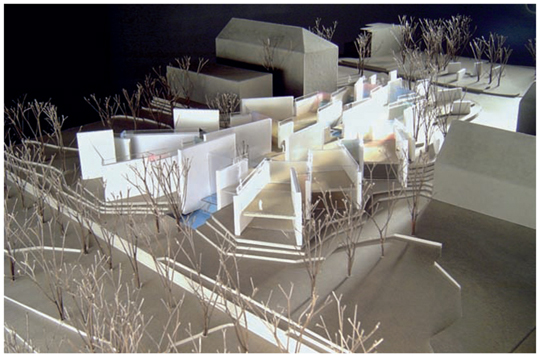
2-18 Interior design model, scale 1:100. Base of honeycomb sandwich panel. Contours in grey cardboard. Wall panels of 3 mm honeycomb. Façade panels and skylight made from acrylic strips. Vegetation made of small alder branches.
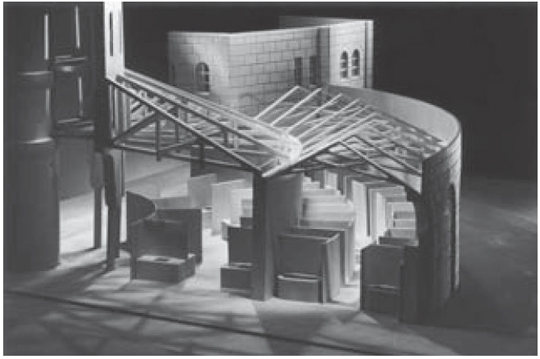
2-19 Detail of interior design model, scale 1:50. Base of 19 mm plywood core of maple, turned on a lathe. Roof joists of CNC-milled airplane plywood. Wall panels of 1 mm airplane plywood, etched masonry pattern with spacers, one wythe thick, double-laminated (ill. 6-55). Partitions of 1.5 mm airplane plywood, furniture of solid wood.
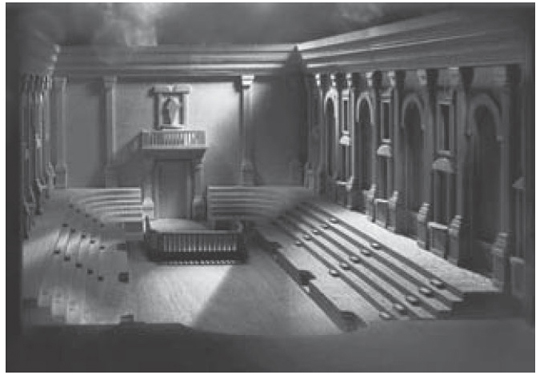
2-20 Interior design model, scale 1:100. Base of 15 mm plywood, outer walls of 9 mm plywood. Balconies, columns, friezes, and cornices trimmed in maple.
Finally, interior design models also serve for trying out color schemes and material selections.
CONCEPTUAL MODELS
Conceptual models are made of interior spaces in order to simulate spatial conditions in the simplest way. For this purpose, a readily available material that can represent interior spaces is used, often just put together provisionally, like scenery.
WORKING MODELS
With the aid of working models, design ideas can be finalized and specific spatial situations decided upon. And at this stage of the process, decisions can still be reached about materials, furnishings, décor, lighting, and sight lines. Models that depict set and stage designs may serve as construction templates for a theater workshop.
PRESENTATION MODELS
Presentation models are made of interior spaces in order to present final design schemes. They are prepared for exhibitions or serve as the basis for discussing furnishing, color, material, and even lighting ideas with project partners and clients. Such models are especially used in the construction of hospitals, administrative buildings, hotels, and other dining facilities, as well as theaters, concert halls, and convention centers.
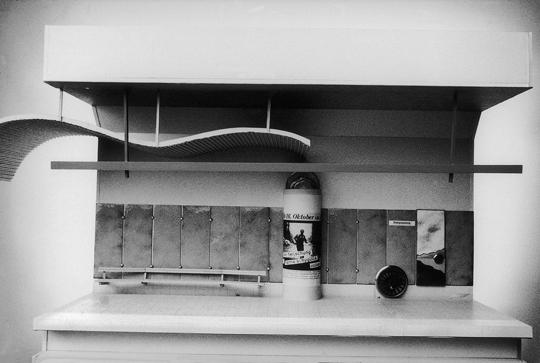
2-21 View of a part of an interior design model used to display material palette and color scheme, scale 1:20.15 mm thick lumber core plywood base; platform, walls, and ceiling of honeycomb board.
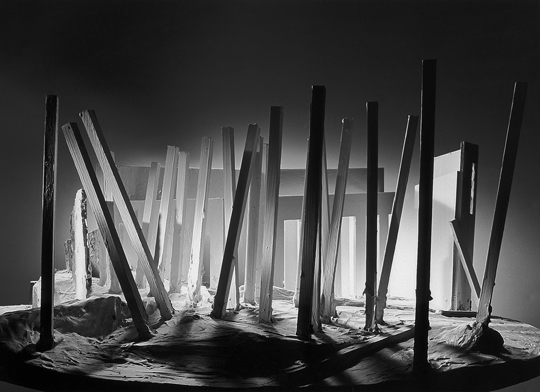
2-22 Set design model. Particleboard base with textured plaster surface. Wall panels, beams. and mullions of solid wood coated with a white emulsion glaze.
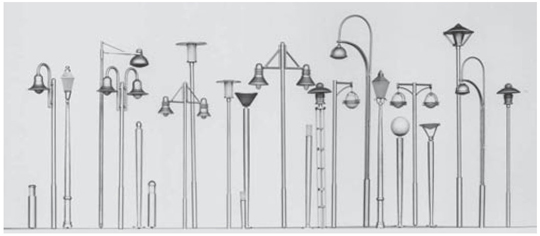
2-23 Model streetlights, scale 1:20. Light poles of brass rods, some soldered to bent piping and rings. Lamps of turned solid wood or Plexiglas.
2.2.5 DETAIL MODELS
With the aid of partial building models and detail models, complex spatial issues and typical details can be designed and clearly depicted. The nature of such details may be structural or involve the formal design. Questions about form, materials, textures, colors, and connection details may be clarified using sectional and detail models. The scale can be between 1:10 and 1:1.
Partial models and detail models are usually based on accurately made technical drawings and design development considerations. This is why they are usually built as presentation models, rather than conceptual models or working models.
PRESENTATION MODELS
Detail models play an important role at this stage of the process: with their help, important decisions are made about structural or formal design alternatives. Additionally, they can be used to study color and materials as well as formal issues.
Many alternative schemes are built for separate parts of buildings. Detail models divide into separate areas: structural connections and details, portions of spaces and façades, and decoration and ornamentation.
2.3 SPECIALTY MODELS
The category of specialty models derives from product design, or the design of objects and furniture. Scales are typically anywhere from 1:10 to 1:1. These models frequently serve as prototypes at the initial phase of the design process; the quality of their fabrication does not differ a great deal from that of final presentation models.
Included among specialty models are those used to study acoustics and lighting, as well as display models used for instructional purposes. Set design models constitute a particular type of specialty model.
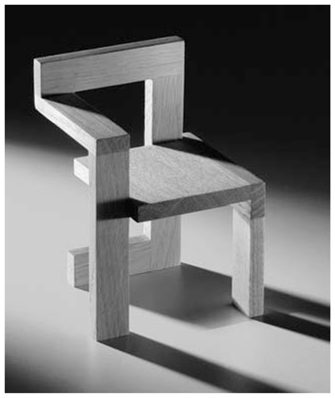
2-24 Model of furniture, scale 1:5, in solid maple.
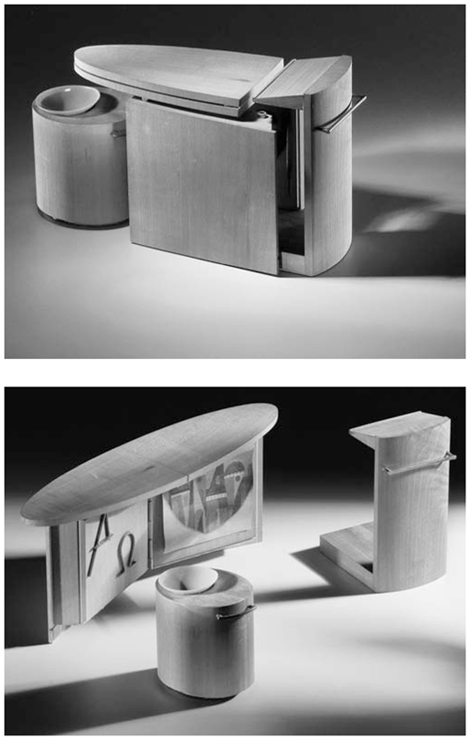
2-25 a,b Model of furnishings, scale 1:10. Furniture parts of solid pear wood, sawn and sanded. Hardware of round brass rods. Script characters of brass strips. Screen of colored paper. Baptismal font of 1 mm thick acrylic, thermally deformed and spray-painted on the back.
a. Put together, the chancel, altar, and baptismal font resemble a closed book.
b. Pulled apart, the altar looks like an open book, and the chancel, into which the other pieces were enclosed, resembles the spine of a book.